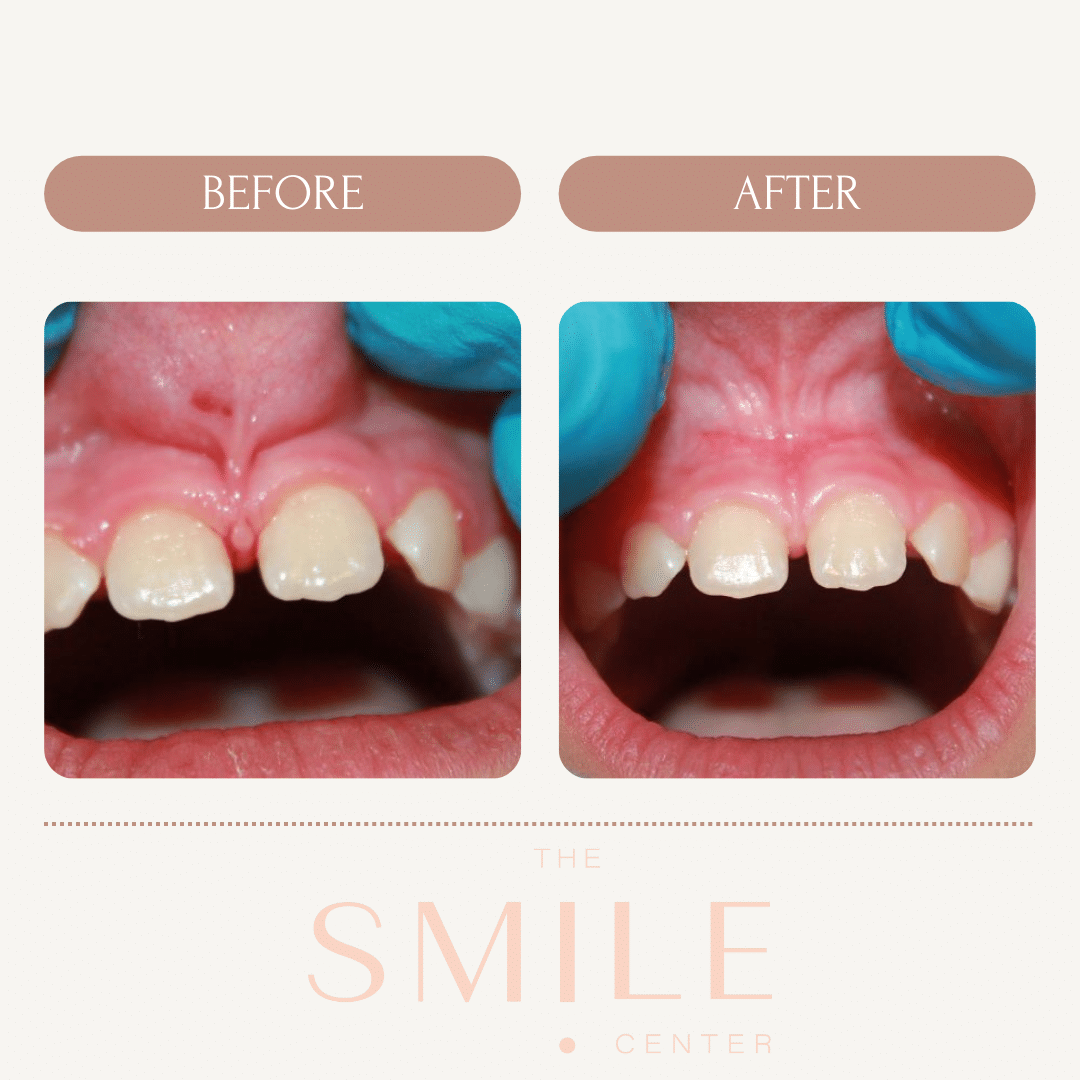Treatment for – Lip and Tongue-Tie
Studies have shown that an estimated 4-11% of babies are born with a tongue-tie.. Lip tie is a similar condition that occurs much less frequently than tongue ties. If you have a child struggling from a lip or tongue tie, you might be seeking treatment to correct the problem. Here is an overview of lip and tongue ties as well as how the Smile Center can reverse the problem with the recommended treatment that is done right in our office.
A tongue tie, or ankyloglossia, is a condition that is present at birth. It causes the collection of tissues, called the lingual frenulum, which is located underneath the tongue, to be too short and can restrict tongue movement.
A lip-tie is similar to a tongue-tie but occurs when the collection of tissue located on the interior of the upper or lower lip and attached to the gums is not long enough, is too thick, or lacks flexibility. Like a tongue tie, a lip tie can prevent the upper or lower lip from moving freely. The band of tissue located in the lip is called the labial frenulum.
Lip or tongue ties can interfere with breastfeeding and speech development issues. If you notice that your baby has been struggling to latch on to the breast or breastfeeding is painful, then a lip or tongue tie could be the cause. An abnormally tight labial frenulum can disrupt the seal around the breast or bottle nipple, leading to increased air intake – contributing to reflux and gas symptoms or breast pain from the tight upper lip. A lip or tongue-tied baby can fail to gain weight, exhibit symptoms of being gassy, and there could be a low milk supply because the child is unable to feed adequately. A lip or tongue tie in older children or adults can lead to speech development issues, poor oral hygiene, and other oral problems.
Lip and tongue tie is genetic, and this dominant gene trait is passed on to the fetus while it is developing in utero. There are different levels of lip and tongue ties, and some are so mild that they don’t interfere with breastfeeding, speech, or hygiene, but others are more severe. The more severe cases must be corrected to improve functionality in the mouth. If left untreated, they can cause speech problems, difficulty maintaining oral hygiene, and even low self-esteem as well as social anxiety.
Lip and tongue ties are corrected through a surgery called a frenectomy. We use a state-of-the-art CO2 laser to perform the procedure. The CO2 laser is the ideal laser for both cutting and coagulating soft tissue during a frenectomy. For laser infant frenectomies, the patient is typically able to feed immediately after the surgery with improved latch and noticeable relief of the mother’s breast pain. Frenectomies are minimally invasive and quick. Most patients recover very quickly and go on to have normal functioning in the area. Pain following a frenectomy is usually mild, and often goes away in 24 hours, but could remain for up to five days. It can be managed with over-the-counter analgesics.
Dr. Butterworth has been using laser technology for soft tissue surgeries, such as frenectomies, since completing his residency training. He has also completed advanced hands-on training specializing in infant and newborn lip and tongue-tie releases.
Prior to treatment at the Smile Center, Dr. Butterworth recommends scheduling a consultation with an Infant OT specialist and chiropractor. Dr. Butterworth has partnered with two Fredericksburg, VA providers, Dr. Hayley Chrzastowski (WILD OT) and Dr. Erica Heppe (Heppe Chiropractic) , This multidisciplinary team approach can assist with establishing optimal oral motor function, and lip/tongue posture early on to support feeding, breathing, sleeping, and speaking habits.
If you are interested in scheduling an appointment for a consultation to discuss a lip or tongue-tie condition or learning more about our oral surgery services, contact us in Fredericksburg or Ashland to schedule your appointment today. We can discuss your specific case, whether it’s for your child or yourself, as we perform oral surgery to correct tongue or lip ties in adults as well as children.

Here at Fredericksburg Smile Center and Ashland Smile Center, we’re proud to make it easy to pay for dental services. We offer high-end dental services at an affordable price. Our staff is trained to help you understand your benefits. We also have financing options that offer low-interest, low-finance plans. Finding affordable dentistry doesn’t have to be intimidating!
Curious if your insurance covers you for a Smile Center exam? Let us check for you.
FREDERICKSBURG:
2330 Plank Road Fredericksburg, VA 22401
Get Directions
Tel: 540-899-7791
Fax: 540-899-8859
[email protected]
ASHLAND:
105 Lee Street Ashland, VA 23005
Get Directions
Tel: 804-798-8447
Fax: 804-496-1250
[email protected]